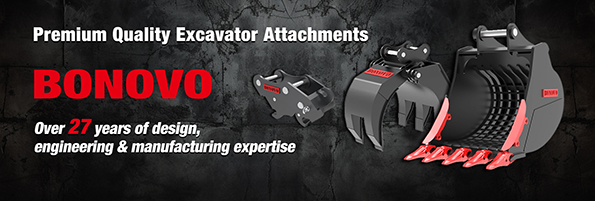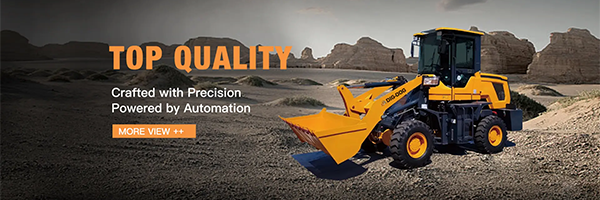In many engineering fields such as construction, mining, and road repair, "1-7 ton excavators" have become common construction equipment due to their flexible operability and wide applicability. The "overhead hydraulic hammer" that matches it has greatly improved the operating capacity of the excavator and has become a powerful assistant for various crushing tasks. This article will give you a detailed introduction to the use of overhead hydraulic hammers to help you complete various engineering tasks efficiently and safely.
Advantages of overhead hydraulic hammers
Efficient crushing capacity
The overhead hydraulic hammer uses advanced hydraulic technology to generate powerful impact force. When facing hard materials such as concrete and rock, it can crush them quickly and effectively, greatly improving work efficiency compared to traditional crushing tools. For example, in urban building demolition projects, for solid concrete structures, the overhead hydraulic hammer can quickly decompose them, greatly shortening the demolition time and meeting the project's requirements for the construction period. This efficient crushing capacity makes it a key factor in improving production efficiency in the working scene of "1-7 ton excavators".
Precise control
Due to its unique design, after the top-mounted hydraulic hammer is installed on the excavator, the operator can precisely control it through the excavator's control system. Whether it is adjusting the impact force or controlling the impact frequency, it can be easily achieved. In some projects that require high crushing accuracy, such as partial demolition work in the restoration of ancient buildings, operators can accurately control the work of the top-mounted hydraulic hammer according to actual needs to avoid unnecessary damage to the surrounding building structures. This precise control feature allows the top-mounted hydraulic hammer to perform well in complex engineering environments and is an ideal match for "1-7 ton excavators" in refined operations.
Strong durability
During the manufacturing process, the top-mounted hydraulic hammer uses high-strength materials and undergoes strict quality inspections, and has excellent durability. In harsh construction environments, such as mining, it can still maintain stable performance and reduce the frequency of failures when dealing with hard rocks for a long time. This not only reduces the maintenance cost of the equipment, but also ensures the continuity of the project. For users of "1 - 7 ton excavators", durable overhead hydraulic hammers mean a higher return on investment because they can work stably for a long time without frequent equipment replacement.
Installation and commissioning
Preparation before installation
Before installing the overhead hydraulic hammer, first make sure that the "1 - 7 ton excavator" is in good condition. Check whether the hydraulic system of the excavator is normal and whether there is any leakage; confirm whether the working device of the excavator, such as the boom and dipper, is firm and not deformed or damaged. At the same time, prepare the tools required for installation, such as wrenches, screwdrivers, etc., and prepare the corresponding installation accessories according to the requirements of the manual. In addition, it is necessary to conduct an appearance inspection of the overhead hydraulic hammer to check whether there is any damage caused during transportation. Only after ensuring that the equipment is intact can it be installed.
Installation steps
Park the excavator on a flat and solid ground, start the engine, and adjust the boom and dipper to a suitable position to facilitate the installation of the overhead hydraulic hammer.
Use a crane or other suitable lifting equipment to slowly lift the overhead hydraulic hammer and align it with the connection part of the excavator. Pay attention to keeping the overhead hydraulic hammer level to avoid collision during installation.
Insert the connecting pin of the overhead hydraulic hammer into the connecting hole of the excavator and fix it firmly with bolts and nuts. When tightening the bolts, operate according to the specified torque to ensure the reliability of the connection.
Connect the hydraulic pipeline. Connect the oil inlet pipe and return pipe of the overhead hydraulic hammer to the oil outlet and return port of the hydraulic system of the excavator respectively. When connecting, pay attention to the direction of the pipeline to avoid twisting or squeezing of the pipeline. At the same time, ensure that the pipeline is tightly connected and there is no leakage.
After the installation is completed, check again whether all connection parts are firm and whether the hydraulic pipeline is connected correctly. After confirmation, start the excavator and perform a no-load test run to check whether the installation of the overhead hydraulic hammer is stable and whether all components are working normally.
Key points for debugging
Pressure adjustment: The striking force of the overhead hydraulic hammer is closely related to the pressure of the hydraulic system. During debugging, it is necessary to adjust the working pressure of the hydraulic hammer through the hydraulic system pressure regulating device of the excavator according to actual work needs. Generally speaking, when crushing harder materials, it is necessary to increase the pressure appropriately; when performing more delicate crushing work, the pressure should be reduced. When adjusting the pressure, it should be done step by step, observing the working state of the overhead hydraulic hammer to avoid damage to the equipment due to excessive or low pressure.
Strike frequency adjustment: Different working scenarios have different requirements for the strike frequency of the overhead hydraulic hammer. By adjusting the flow control valve in the hydraulic system of the excavator, the flow of hydraulic oil entering the hydraulic hammer can be changed, thereby adjusting the strike frequency. For example, when crushing concrete pavement over a large area, a higher strike frequency can improve work efficiency; while when demolishing the structure inside the building, a lower strike frequency is more conducive to precise control. When debugging the strike frequency, it is necessary to combine the actual working situation to find the most suitable frequency setting.
Operation skills
Correct grip posture
When operating a "1-7 ton excavator" equipped with an overhead hydraulic hammer, the operator should maintain a correct grip posture. Both hands should hold the operating handle of the excavator firmly, sit upright, and maintain a good line of sight. This ensures that during operation, the action of the overhead hydraulic hammer can be accurately and timely controlled to avoid accidents caused by improper operation. At the same time, the correct gripping posture can also reduce the fatigue of the operator and improve work efficiency.
Choose the right striking angle
The striking angle of the overhead hydraulic hammer has an important influence on the crushing effect. During operation, the drill rod of the hydraulic hammer should be kept perpendicular to the surface of the crushed object as much as possible. This allows the impact force to act evenly on the object, improves the crushing efficiency, and reduces the wear of the drill rod. If the striking angle is improper, it will not only reduce the crushing effect, but may also cause the drill rod to break or the equipment to be damaged. For example, when crushing rocks, the position of the excavator should be adjusted according to the shape and structure of the rock so that the overhead hydraulic hammer can strike at the best angle.
Avoid empty strikes
Empty strikes refer to the overhead hydraulic hammer striking without contacting the crushed object. Empty strikes will cause great damage to the hydraulic hammer and shorten its service life. Therefore, during operation, the operator should always pay attention to the working status of the overhead hydraulic hammer to ensure that the drill rod has contacted the crushed object before each strike. At the same time, the movement of the excavator should be reasonably controlled to avoid the occurrence of empty hitting due to operational errors. For example, when moving the excavator, the overhead hydraulic hammer should be raised in advance to avoid it accidentally touching the ground during the movement and causing empty hitting.
Maintenance and care
Daily inspection
Daily inspection should be carried out before using the overhead hydraulic hammer every day. The inspection content includes whether the appearance of the hydraulic hammer is damaged, whether the connection parts are loose, whether the hydraulic pipeline is leaking, etc. At the same time, the wear of the drill rod should also be checked. If the drill rod is severely worn, it should be replaced in time. In addition, the hydraulic oil level of the excavator should be checked to ensure that the hydraulic system can work normally. Through daily inspection, problems with the equipment can be discovered in time to avoid failures during the work process and affect the progress of the project.
Regular maintenance
Regular maintenance is essential for the long-term and stable operation of the overhead hydraulic hammer. Generally speaking, the hydraulic hammer needs to be maintained every certain working time or working hours. The maintenance content includes replacing the hydraulic oil, cleaning the hydraulic filter, checking the wear of each component and performing necessary repairs or replacements. When replacing hydraulic oil, choose high-quality hydraulic oil that meets the requirements of the equipment and replace it according to the prescribed method. Cleaning the hydraulic filter can ensure the cleanliness of the hydraulic system and prevent impurities from entering the system and damaging the equipment. Through regular maintenance, the service life of the overhead hydraulic hammer can be extended and its working performance can be improved.
Maintenance in special environments
When using an overhead hydraulic hammer in some special environments, such as high temperature, humidity, and dust, it is necessary to strengthen maintenance work. In a high temperature environment, pay attention to the temperature of the hydraulic oil to avoid equipment failure caused by excessive oil temperature. The oil temperature can be reduced by adding a radiator or improving ventilation conditions. In a humid environment, prevent the equipment from rusting and regularly perform rust prevention on the equipment. In a dusty environment, frequently clean the dust on the surface of the equipment to prevent dust from entering the hydraulic system and affecting the normal operation of the equipment. Taking corresponding maintenance measures for different special environments can ensure that the overhead hydraulic hammer can still operate reliably under harsh conditions.
As an ideal supporting equipment for "1-7 ton excavators", the overhead hydraulic hammer plays an important role in various projects. By understanding its advantages and mastering the correct installation, commissioning, operation skills and maintenance methods, users can give full play to the performance of overhead hydraulic hammers, improve work efficiency, reduce equipment failure rate, and provide strong guarantee for the smooth progress of the project. I hope that the user guide in this article can help you better use overhead hydraulic hammers and achieve efficient and safe engineering operations.
Overhead Hammer User Guide: Best Choice for 1-7 Ton Excavators
- BONOVO
- Counselor
- Posts: 645
- Joined: Oct 17th, '24, 02:50
- Location: China
Overhead Hammer User Guide: Best Choice for 1-7 Ton Excavators
Choose BONOVO for high-quality, customizable brush cutters for skid steers with fast delivery. Contact us today to discover how our superior products can enhance your land management tasks!
for more info just visit our website at www.bonovogroup.com
contact # : +86 158 6218 2088
email : sales@bonovogroup.com
for more info just visit our website at www.bonovogroup.com
contact # : +86 158 6218 2088
email : sales@bonovogroup.com

